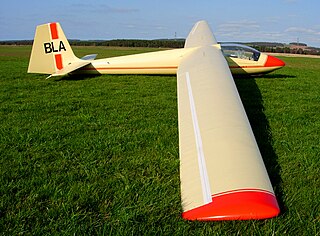Related Research Articles
The A-2 Vautour (Vulture) was a single-seat French glider that was designed by Georges Abrial. It performed well at the Vauville competition of 1925.

The Slingsby Type 42 Eagle was a two-seat glider designed in England from 1952.

The Levasseur-Abrial A-1 was a glider built in 1922 as a result of a collaboration between French aerodynamicist Georges Abrial de Péga and constructor Pierre Levasseur. A single example was built, which was destroyed on its fourth flight.

The SZD-6x Nietoperz was a single-seat tail-less experimental glider aircraft that was designed and built in Poland at Szybowcowy Zakład Doświadczalny in Bielsko-Biała in 1951. Only one example was constructed.

The Slingsby Type 45 Swallow was designed as a club sailplane of reasonable performance and price. One of the most successful of Slingsby's gliders in sales terms, over 100 had been built when production was ended by a 1968 factory fire.

The Slingsby T.50 Skylark 4 was a British single seat competition glider built by Slingsby Sailplanes in the early 1960s. It sold in numbers and had success at national, though not world level competition.

The Ikarus Meteor is a long-span, all-metal sailplane designed and built in Yugoslavia in the 1950s. It competed in World Gliding Championships (WGC) between 1956 and 1968 and was placed fourth in 1956; it also set new triangular-course world speed records.

The Caudron C.800, at first also known as the Epervier is a French two seat training glider, designed and first flown during World War II and put into large scale post-war production. It was the dominant basic training glider with French clubs until the 1960s and several still fly.
The CVT1 Zigilo was a single-seat, 12-metre-span (39 ft) Italian training glider designed and built in Italy in the 1950s. Only one was completed.

The Delanne 20-T was a French tandem wing aircraft designed as an aerodynamic model for a larger fighter aircraft. It was tested during 1939.

The Delanne 11 was a French two seat touring aircraft. Only one was built.
The Delanne 30 P2 was a two-seat, French high performance glider built shortly before World War II.

The Avia 41-P was a high performance French glider. Eric Nessler set many new national gliding records in one between 1934 and 1938.

The Avia 40-P was intended as an economical glider suitable for clubs and individuals but with a competitive performance capable of record setting. It was the most popular pre-war French glider, with more than forty built and it continued to set records immediately after World War II.
The Avia 50-MP was a French motor glider based on that of the Avia XV-A training glider. First flown in 1934, it was intended to introduce pilots to motor-gliders.
The Avia 60-MP was a French motor glider with a wing based on that of the Avia 32-E, an advanced training glider. It was intended as both an advanced trainer and as an atmospheric research aircraft.
The Castel C.34 Condor was a French high performance sailplane. Two were built and one at least served French gliding clubs from 1935 to the outbreak of World War II in 1939.
The Leduc RL-12 was a French low power, economical, parasol wing, single seat aircraft. First flown in July 1939, its development was halted by World War II.
The RRG Delta I was a German experimental tailless aircraft flown in the early 1930s first as a glider and then powered. It was one of the first delta wing aircraft.
The LFG Phönix, also known as LFG Segelflugboot Phönix,LFG Boot-Phönix and Phönix 3, was a single seat flying boat glider built in Germany in the early 1920s.
References
- 1 2 3 4 5 "Un Planeur pour le Brevet D: le Delanne 60-E.1". Les Ailes (917): 15. 27 December 1938.
- 1 2 "La fête du C.O.B. au terrain d'Etampes". Les Ailes (945): 12. 27 July 1939.
- ↑ "Le Vol sans Moteurs - le planeur, Nessler a traversé Paris; Un Concours National à la Banne d'Ordanche" (896). 11 August 1938: 3.
{{cite journal}}: Cite journal requires|journal=(help) - ↑ "Les planeurs au Grand-Palais". Les Ailes (911): 9. 1 December 1938.
- ↑ "Vendrons-nous des planeurs au Japon?". Les Ailes (912): 16. 6 December 1938.
- ↑ "De Moiselles à Besançon". Les Ailes (942): 12–13. 6 July 1939.
- ↑ "Le Vol sans Moteur - L'activité du Groupe "L'Air"". Les Ailes (914): 12. 12 January 1939.
- ↑ "Le Vol sans Moteur - L'activité du Groupe "L'Air" en 1938". Les Ailes (925): 14. 9 March 1939.
- ↑ "Le meeting de Saint-Germain". Les Ailes (937): 12. 1 June 1939.
- ↑ "Image". Les Ailes (938): 12. 8 June 1939.